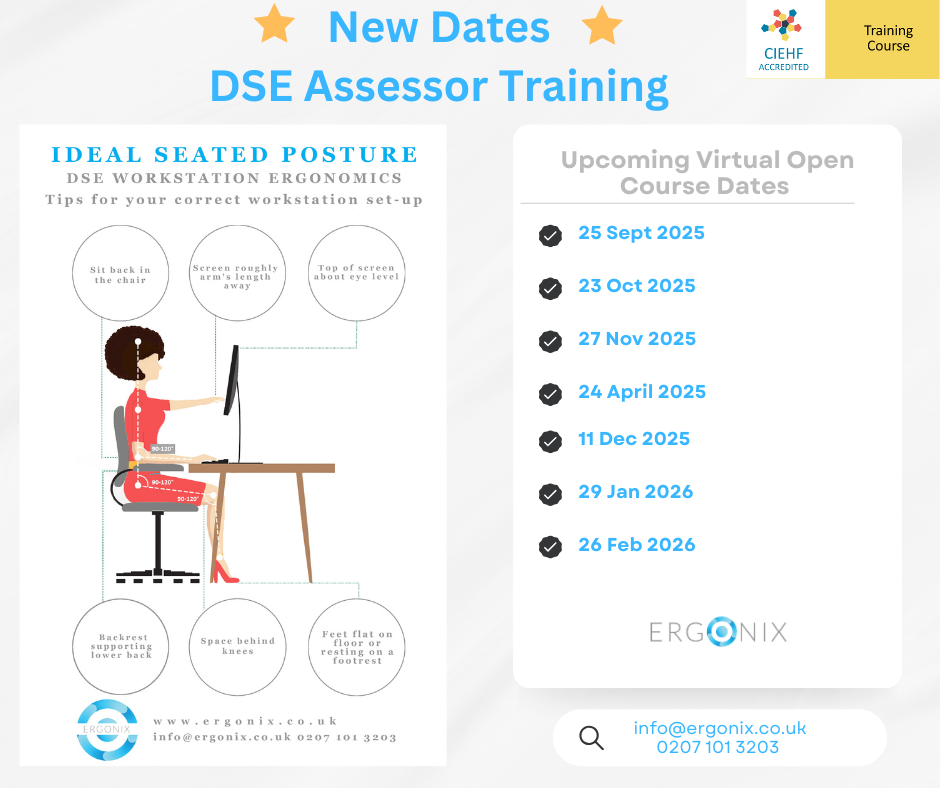 Improving workplace ergonomics goes beyond rearranging furniture; it’s a strategic initiative with the potential to boost, when executed thoughtfully, productivity and overall employee wellbeing. However, the key success of ergonomic changes hinges on more than just reshuffling office furniture – it requires a comprehensive approach that involves understanding the rationale and methods behind these adjustments.
Improving workplace ergonomics goes beyond rearranging furniture; it’s a strategic initiative with the potential to boost, when executed thoughtfully, productivity and overall employee wellbeing. However, the key success of ergonomic changes hinges on more than just reshuffling office furniture – it requires a comprehensive approach that involves understanding the rationale and methods behind these adjustments.
What Tends to Go Wrong?
A common pitfall in implementing ergonomic adjustments is the lack of clarity surrounding the reasons behind these changes. Employees might be handed a new piece of equipment such as a monitor, chair, keyboard, or a mouse without grasping the benefits of these modifications bring. Without a clear understanding of the purpose, they might perceive it as another arbitrary policy lacking real value.
Bridging this knowledge gap is crucial. Educating employees on the rationale behind DSE (display screen equipment) workstation assessments and adjustments can make a substantial difference. Clarify how these changes mitigate the risk of aches and pains, musculoskeletal injuries, enhance comfort, and ultimately boost productivity. When employees recognise that these adjustments are geared toward improving their wellbeing and efficiency, resistance tends to dissipate.
Cultural and Budgetary Hurdles
Implementing ergonomic changes in an organisation faces significant challenges rooted in both organisational culture and budget constraints, impacting the success and sustainability of such initiatives.
Organisational culture challenges, including resistance to change, lack of emphasis on employee wellbeing, and a productivity-centric mind-set, can lead to scepticism and reluctance. An organisation’s culture can influence the degree to which employees feel included in decision-making processes. Involving employees in discussions about ergonomic changes fosters a sense of ownership and can help overcome resistance arising from a perception of arbitrary policy implementation. Communication gaps and insufficient inclusivity in decision-making processes exacerbate these challenges. Therefore, fostering open communication channels and involving employees in the decision-making process are essential strategies to create a culture that supports and embraces ergonomic changes.
Budget constraints further pose obstacles, limiting investment in quality ergonomic equipment and hindering long-term financial planning. Organisations should view ergonomic investments as long-term strategies for employee wellbeing and productivity, understanding that the initial costs can lead to significant returns in terms of reduced absenteeism and increased efficiency. Overcoming hurdles requires a concerted effort to shift organisational culture towards valuing employee wellbeing and recognising ergonomic investments as essential for sustained productivity and reduced absenteeism.
Navigating the “Optimal Way”
Implementing ergonomic workstation assessments extends beyond mere furniture rearrangement; employees must be well-versed in the optimal setup of their DSE workstations to fully experience the benefits. Lack of explicit direction on best practices, even adjustments made with the best intentions may result in aches and pains and potential musculoskeletal injuries including in the wrist, shoulder, neck and back.
Providing equipment without proper training on how to use it can hinder the effectiveness of ergonomic adjustments. Employees may not derive the intended benefits if they are not using the equipment correctly. Delivering comprehensive education on adjusting workstation equipment, optimising the environment, managing breaks, and promoting movement is not merely essential but also a legal requirement under HSE (Health and Safety Executive) DSE law. This ensures employees understand the underlying reasons behind optimising their workplace, breaks, and the importance of incorporating movement. This comprehensive approach, whether through DSE wellbeing workshops, training sessions, or user-friendly guides, empowers employees to make informed decisions, fostering greater adherence and comprehension.
Move More
In the pursuit of workplace wellbeing and productivity, integrating regular movement into the daily routine is a cornerstone of success. The importance of movement extends beyond ergonomic adjustments and plays a vital role in promoting overall health. Encouraging employees to move more throughout the workday not only enhances physical wellbeing but also contributes to heightened productivity and mental wellness.
Research consistently demonstrates the positive impact of physical activity on reducing the risk of chronic conditions, improving mood, and increasing energy levels. Incorporating movement breaks, whether through short walks, stretching exercises, or quick desk workouts, can alleviate tension, enhance concentration, and reduce the risk of musculoskeletal issues. Moreover, regular movement is linked to increased creativity and problem-solving abilities, fostering a dynamic and innovative work environment.
Organisations can play a pivotal role in promoting a culture of movement. By integrating physical activity into workplace policies and providing dedicated spaces for exercise or stretching, organisations signal their commitment to employee health and wellbeing. Moreover, fostering a supportive atmosphere where colleagues encourage each other to take short breaks and move throughout the day can contribute to a positive workplace culture.
While the challenges of implementing workplace ergonomics are acknowledged, it is equally crucial to recognise the value of movement in creating a holistic approach to employee wellbeing. As organisations navigate the path to optimal workplace health, integrating movement into daily practices can become a catalyst for sustained productivity, reduced absenteeism, and a workplace where employees thrive both physically and mentally.
Tailor it to Your Employees’ Needs
Acknowledging that ergonomics isn’t a universal solution is pivotal. Individuals vary in many ways, encompassing factors such as physique, work habits, and activities. Neglecting these individual needs can result in discomfort and, ultimately, render ergonomic adjustments ineffective. Therefore, incorporating a holistic DSE workstation assessment, tailoring the assessment and recommendations to the individual needs is essential to ensure comprehensive and tailored solutions for each individual’s unique requirements.
Therefore, advice should be tailored to address the unique needs of each individual, making it a central focus of education. It is crucial to convey to employees that not only is personalising their workstations acceptable, but it is also essential. This emphasis plays a crucial role in ensuring that DSE workstation adjustments are not only meaningful but also enduring and successful.
Sustain Support/ Follow-ups
Sustaining support and conducting follow-ups in ergonomic education are integral components of fostering a thriving workplace environment. Recognising that ergonomic adjustments are not a one-time event but rather an ongoing journey is crucial for the long-term success of these initiatives. Beyond the initial implementation, follow-up sessions are essential to the effectiveness of the ergonomic adjustments and aid in gathering valuable feedback from employees. This continual engagement allows employers to address any emerging issues promptly and fine-tune the ergonomic solutions to meet the evolving needs of the workforce. Open communication channels play a pivotal role in this process, enabling a two-way dialogue where employees can express their experiences, concerns, and suggestions. Through consistent follow-ups, employers demonstrate their commitment to employee wellbeing and their responsiveness to the dynamic nature of the workplace. This proactive approach not only ensures that ergonomic adjustments remain effective but also contributes to a positive organisational culture that values and prioritises the health, comfort, and productivity of its workforce over the long term.
Navigating the path to workplace wellbeing and productivity through ergonomic interventions is a comprehensive endeavour that extends beyond physical adjustments. In the realm of DSE workstation assessments, understanding and addressing the complexities of organisational culture and budgetary constraints become pivotal. Effectively managing resistance, fostering inclusivity in decision-making, and highlighting the long-term strategic value of DSE workstation investments contribute to creating a workplace culture that actively supports and embraces ergonomic changes. Moreover, tailoring DSE workstation solutions to the individual needs of employees ensures a more meaningful and enduring impact, recognising the diverse factors at play, including physique, work habits, and activities. This tailored approach emphasises the significance of personalising workstations and reinforces the understanding that it is not only acceptable but also essential for optimal outcomes. As the journey progresses, sustaining support through consistent follow-ups and open communication becomes paramount. This continual commitment to DSE workstation assessments ensures that the benefits of ergonomic adjustments persist over time, fostering a work environment where employee wellbeing and productivity thrive hand in hand.
If you are interested in exploring how our DSE Services can support your organisation’s goals, we invite you to get in touch.
Accredited DSE Workstation Assessor Course







